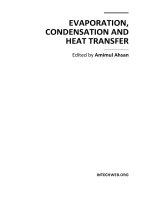Evaporation Condensation and Heat transfer Part 1 docx
Bạn đang xem bản rút gọn của tài liệu. Xem và tải ngay bản đầy đủ của tài liệu tại đây (1.72 MB, 40 trang )
EVAPORATION,
CONDENSATION AND
HEAT TRANSFER
Edited by Amimul Ahsan
Evaporation, Condensation and Heat Transfer
Edited by Amimul Ahsan
Published by InTech
Janeza Trdine 9, 51000 Rijeka, Croatia
Copyright © 2011 InTech
All chapters are Open Access articles distributed under the Creative Commons
Non Commercial Share Alike Attribution 3.0 license, which permits to copy,
distribute, transmit, and adapt the work in any medium, so long as the original
work is properly cited. After this work has been published by InTech, authors
have the right to republish it, in whole or part, in any publication of which they
are the author, and to make other personal use of the work. Any republication,
referencing or personal use of the work must explicitly identify the original source.
Statements and opinions expressed in the chapters are these of the individual contributors
and not necessarily those of the editors or publisher. No responsibility is accepted
for the accuracy of information contained in the published articles. The publisher
assumes no responsibility for any damage or injury to persons or property arising out
of the use of any materials, instructions, methods or ideas contained in the book.
Publishing Process Manager Ivana Lorkovic
Technical Editor Teodora Smiljanic
Cover Designer Jan Hyrat
Image Copyright Oshchepkov Dmitry, 2010. Used under license from Shutterstock.com
First published August, 2011
Printed in Croatia
A free online edition of this book is available at www.intechopen.com
Additional hard copies can be obtained from
Evaporation, Condensation and Heat Transfer, Edited by Amimul Ahsan
p. cm.
ISBN 978-953-307-583-9
free online editions of InTech
Books and Journals can be found at
www.intechopen.com
Contents
Preface IX
Part 1 Evaporation and Boiling 1
Chapter 1 Evaporation Phenomenon Inside a Solar Still:
From Water Surface to Humid Air 3
Amimul Ahsan, Zahangir Alam, Monzur A. Imteaz,
A.B.M. Sharif Hossain and Abdul Halim Ghazali
Chapter 2 Flow Boiling in an Asymmetrically
Heated Single Rectangular Microchannel 23
Cheol Huh and Moo Hwan Kim
Chapter 3 Experimental and Computational Study
of Heat Transfer During Quenching of Metallic Probes 49
B. Hernández-Morales, H.J. Vergara-Hernández,
G. Solorio-Díaz and G.E. Totten
Chapter 4 Two Phase Flow Experimental Study Inside a Microchannel:
Influence of Gravity Level on Local Boiling Heat Transfer 73
Sébastien Luciani
Chapter 5 The Evolution of Temperature Disturbances During Boiling
of Cryogenic Liquids on Heat-Releasing Surfaces 95
Irina Starodubtseva and Aleksandr Pavlenko
Chapter 6 Pool Boiling of Liquid-Liquid Multiphase Systems 123
Gabriel Filipczak, Leon Troniewski and Stanisław Witczak
Part 2 Condensation and Cooling 151
Chapter 7 Steam Condensation in the Presence
of a Noncondensable Gas in a Horizontal Tube 153
Kwon-Yeong Lee and Moo Hwan Kim
VI Contents
Chapter 8 Experimental Study
for Condensation Heat Transfer Inside Helical Coil 169
Mohamed A. Abd Raboh, Hesham M. Mostafa,
Mostafa A. M. Ali
and Amr M. Hassaan
Chapter 9 Modelling the Thermo-Hydraulic Performance
of Cooling Networks and Its Implications
on Design, Operation and Retrofit 189
Martín Picón-Núñez, Lázaro Canizalez-Dávalos
and Graham T. Polley
Chapter 10 Heat Exchange in Furnace Side Walls
with Embedded Water Cooled Cooling Devices 207
Gabriel Plascencia
Part 3 Heat Transfer and Exchanger 225
Chapter 11 Heat Transfer in Buildings: Application
to Solar Air Collector and Trombe Wall Design 227
H. Boyer, F. Miranville, D. Bigot, S. Guichard, I. Ingar,
A. P. Jean, A. H. Fakra, D. Calogine and T. Soubdhan
Chapter 12 Heat Transfer in the Transitional Flow Regime 245
JP Meyer and JA Olivier
Chapter 13 Numerical Modeling of Cross-Flow Tube
Heat Exchangers with Complex Flow Arrangements 261
Dawid Taler, Marcin Trojan and Jan Taler
Chapter 14 Metal Foam Effective Transport Properties 279
Jean-Michel Hugo, Emmanuel Brun and Frédéric Topin
Chapter 15 Heat Transfer Performances
and Exergetic Optimization for Solar Heat Receiver 303
Jian-Feng Lu and Jing Ding
Chapter 16 Soret and Dufour Effects on Steady MHD Natural
Convection Flow Past a Semi-Infinite Moving Vertical
Plate in a Porous Medium with Viscous Dissipation
in the Presence of a Chemical Reaction 325
Sandile Motsa
and Stanford Shateyi
Part 4 Fluid and Flow 347
Chapter 17 Computational Fluid Dynamic Simulations
of Natural Convection in Ventilated Facades 349
A. Gagliano, F. Patania, A. Ferlito, F. Nocera and A. Galesi
Contents VII
Chapter 18 Turbulent Heat Transfer
in Drag-Reducing Channel Flow of Viscoelastic Fluid 375
Takahiro Tsukahara and Yasuo Kawaguchi
Chapter 19 Fluid Flow and Heat Transfer Analyses
in Curvilinear Microchannels 401
Sajjad Bigham and Maryam Pourhasanzadeh
Chapter 20 Effects of Fluid Viscoelasticity in Non-Isothermal Flows 423
Tirivanhu Chinyoka
Chapter 21 Different Approaches for Modelling
of Heat Transfer in Non-Equilibrium Reacting Gas Flows 439
E.V. Kustova and E.A. Nagnibeda
Chapter 22 High-Carbon Alcohol Aqueous Solutions
and Their Application to Flow Boiling
in Various Mini-Tube Systems 465
Naoki Ono, Atsushi Hamaoka, Yuki Eda and Koichi Obara
Chapter 23 Heat Transfer and Hydraulic Resistance
in Rough Tubes Including with Twisted Tape Inserts 487
Stanislav Tarasevich and Anatoly Yakovlev
Chapter 24 Fluid Mechanics, Heat Transfer
and Thermodynamic Issues of Micropipe Flows 511
A. Alper Ozalp
Chapter 25 Fundamentals of Paper Drying –
Theory and Application from Industrial Perspective 535
Ajit K Ghosh
Preface
The theoretical analysis and modeling of heat and mass transfer rates produced in
evaporation and condensation processes are significant issues in a design of wide
range of industrial processes and devices. This book introduces advanced processes
and modeling of evaporation, boiling, water vapor condensation, cooling, heat
transfer, heat exchanger, fluid dynamic simulations, fluid flow, and gas flow to the
international community. It includes 25 advanced and revised contributions, and it
covers mainly (1) evaporation and boiling, (2) condensation and cooling, (3) heat
transfer and exchanger, and (4) fluid and flow.
The first section introduces evaporation phenomenon, flow boiling, heat transfer
during quenching, two-phase flow, temperature disturbances during boiling, and pool
boiling.
The second section covers steam condensation, condensation inside helical coil,
thermo-hydraulic performance of cooling networks, heat exchange with embedded
cooling devices, and solar cooling systems.
The third section includes heat transfer in heat-released rod bundles, in buildings, in
transitional flow regime, in stretching sheet, and in solar heat receiver, photovoltaic
module thermal regulation, relative-air humidity sensing element, cross-flow tube
heat exchanger, spiral plate heat exchanger, metal foam transport properties, and soret
and dufour effects. The forth section presents computational fluid dynamic
simulations, turbulent heat transfer, fluid flow, fluid viscoelasticity, non-equilibrium
reacting gas flows, high-carbon alcohol aqueous solutions, hydraulic resistance in
rough tubes, fluid mechanics, thermodynamic, and fundamental of paper drying.
The readers of this book will appreciate the current issues of modeling on evaporation,
water vapor condensation, heat transfer and exchanger, and on fluid flow in different
aspects. The approaches would be applicable in various industrial purposes as well.
The advanced idea and information described here will be fruitful for the readers to
find a sustainable solution in an industrialized society.
The editor of this book would like to express sincere thanks to all authors for their high
quality contributions and in particular to the reviewers for reviewing the chapters.
X Preface
ACKNOWLEDGEMENTS
All praise be to Almighty Allah, the Creator and the Sustainer of the world, the Most
Beneficent, Most Benevolent, Most Merciful, and Master of the Day of Judgment. He is
Omnipresent and Omnipotent. He is the King of all kings of the world. In His hand is
all good. Certainly, over all things Allah has power.
The editor would like to express appreciation to all who have helped to prepare this
book. The editor expresses the gratefulness to Ms. Ivana Lorkovic, Publishing Process
Manager, InTech Open Access Publisher, for her continued cooperation. In addition,
the editor appreciatively remembers the assistance of all authors and reviewers of this
book.
Gratitude is expressed to Mrs. Ahsan, Ibrahim Bin Ahsan, Mother, Father, Mother-in-
Law, Father-in-Law, and Brothers and Sisters for their endless inspirations, mental
supports and also necessary help whenever any difficulty.
Amimul Ahsan, Ph.D.
Department of Civil Engineering
Faculty of Engineering
University Putra Malaysia
Malaysia
Part 1
Evaporation and Boiling
1
Evaporation Phenomenon Inside a Solar Still:
From Water Surface to Humid Air
Amimul Ahsan
1,5
, Zahangir Alam
2
, Monzur A. Imteaz
3
,
A.B.M. Sharif Hossain
4
and Abdul Halim Ghazali
1
1
University Putra Malaysia, Department of Civil Engineering, Faculty of Engineering,
2
International Islamic University Malaysia, Department of Biotechnology Engineering,
Faculty of Engineering,
3
Swinburne University of Technology, Faculty of Engineering and Industrial Science,
4
University of Malaya, Institute of Biological Sciences, Faculty of Science,
5
Green Engineering and Sustainable Technology Lab, Institute of Advanced Technology,
1,2,4
Malaysia
3
Australia
1. Introduction
Solar stills of different designs have been proposed and investigated with a view to get
greater distillate output (Murase et al., 2006). Solar stills are usually classified into two
categories: a single-effect type and a multi-effect type that reuses wasted latent heat from
condensation (Fath, 1998; Toyama et al., 1990). The integration between a solar collector and
a still is classified into passive and active stills (Tiwari & Noor, 1996; Kumar & Tiwari; 1998).
Single-effect passive stills are composed of convectional basin, diffusion, wick and
membrane types (Murase et al., 2000; Korngold et al., 1996). The varieties of a still with
cover cooling (Abu-Arabi et al., 2002; Abu-Hijleh et al., 1996) and a still with a multi-effect
type basin (Tanaka et al., 2000) have been studied.
A basin-type solar still is the most common among conventional solar stills (Chaibi, 2000;
Nafey et al., 2000; Hongfei et al., 2002; Paul, 2002; Al-Karaghouli & Alnaser, 2004; Tiwari &
Tiwari, 2008). A small experimental Tubular Solar Still (TSS) was constructed to determine
the factors affecting the nocturnal production of solar stills (Tleimat & Howe, 1966).
Furthermore, a detailed analysis of this TSS of any dimensions for predicting its nocturnal
productivity was presented (Tiwari & Kumar, 1988). They (Tleimat & Howe, 1966; Tiwari &
Kumar, 1988) mainly focused on the theoretical analysis of the nocturnal production of TSS.
A simple transient analysis of a tubular multiwick solar still was presented by Kumar and
Anand (1992). This TSS (Tleimat & Howe, 1966; Tiwari & Kumar, 1988; Kumar & Anand,
1992) is made of heavy glass and cannot be made easily in remote areas. The cost of glass is
quite high as well (Ahsan et al., 2010).
When water supply is cut off due to natural disasters (tsunamis, tornados, hurricanes,
earthquakes, landslides, etc.) or unexpected accidents, a lightweight compact still, which is
made of cheap and locally acquired materials, would be reasonable and practical. The
second model of the TSS was, therefore, designed to meet these requirements and to
improve some of the limitations of the basin-type still and of the TSS made of glass. Since
Evaporation, Condensation and Heat Transfer
4
the cover material (a vinyl chloride sheet) is a little heavy and cannot form into an ideal size
easily (Islam, 2006; Fukuhara & Islam, 2006; Islam et al., 2005; Islam et al., 2007a), a
polythene film was adopted as a cheap new material for the cover. Consequently, the cover
weight and the cost of the second model were noticeably reduced and the durability was
distinctly increased. These improvements also can help to assemble and to maintenance the
second model of TSS easily for sustainable use (Ahsan et al., 2010). A complete numerical
analysis on TSS has been presented by Ahsan & Fukuhara, 2008; Ahsan, 2009; Ahsan &
Fukuhara, 2009; Ahsan & Fukuhara, 2010a, 2010b.
Many researchers (Chaibi, 2000; Clark, 1990; Cooper, 1969; Dunkle, 1961; Hongfei et al.,
2002; Malik et al., 1982; Shawaqfeh & Farid, 1995) have focused their research on
conventional basin type stills rather than other types such as tubular still. Most of the heat
and mass transfer models of the solar still have been described using temperature and vapor
pressure on the water surface and still cover, without noting the presence of intermediate
medium, i.e. humid air (Dunkle, 1961; Kumar & Anand, 1992; Tiwari & Kumar, 1988). Nagai
et al. (2011) and Islam et al. (2007b), however, found that the relative humidity of the humid
air is definitely not saturated in the daytime. Islam (2006) formulated the evaporation in the
TSS based on the humid air temperature and on the relative humidity in addition to the
water temperature and obtained an empirical equation of the evaporative mass transfer
coefficient. Since the empirical equation does not have a theoretical background, it is still not
known whether it can be used, when the trough size (width or length) is changed (Ahsan &
Fukuhara, 2008).
In this chapter, a comparison of the evaporation and distilled water production between the
first model and second one is described. Additionally, this chapter aims to present the
theoretical formulation of a model for the evaporation in a TSS by dimensional analysis.
2. Production principle
The TSS consists of a transparent tubular cover and a black semicircular trough inside the
tubular cover. The solar radiant heat after transmitting through a transparent tubular cover
is mostly absorbed by water in the trough. Consequently, the water is heated up and
evaporates. The water vapor density of the humid air increases associated with the
evaporation from the water surface and then the water vapor is condensed on the inner
surface of the tubular cover, releasing its latent heat of vaporization. Finally, the condensed
water naturally trickles down toward the bottom of the tubular cover due to gravity and
then is stored into a collector through a pipe equipped at the lower end of the tubular cover
(Ahsan et al., 2010).
3. Overview of first model and second one
3.1 Structure of TSS
Fig. 1(a) shows the cross section of the second model of the TSS. The frame was assembled
with six GI pipes and six GI rings arranged in longitudinal and transverse directions,
respectively. The GI pipe was 0.51m in length and 6mm in diameter. The GI ring was 0.38m
in length and 2mm in diameter. The reasons for selection of GI material are light weight,
cheap, available in market and commonly used in different purposes. The frame was
wrapped with a tubular polythene film. The film is easily sealed by using a thermal-
adhesion machine (Ahsan et al., 2010).
Evaporation Phenomenon Inside a Solar Still: From Water Surface to Humid Air
5
Tubular cover
Trough
Water
Electric
balance
Solar simulator
Support of trough
Evaporation
Water
Distilled water
Cross section at A-A
Evaporation
Distilled water
Cross section at A-A
Trough
Polythene film
V
inyl chloride sheet
A
A
C
C
Electric balance (only for second model)
a) Second model b) First model
Fig. 1. Schematic diagram of the experiment (Ahsan et al., 2010)
The tubular cover of the first model designed by the research group was made of a
transparent vinyl chloride sheet 0.5mm in thickness (Fukuhara et al., 2002; Islam et al., 2004).
The cross section of the first model is shown in Fig. 1(b) (Ahsan et al., 2010).
The specifications of TSS for both first and second models are summarized in Table 1.
Both models have the same trough made of vinyl chloride 1.0mm in thickness. Since the
attached lid at the end of the tubular cover can be removed easily, the trough can be
promptly taken out and inserted back after flushing the accumulated salt in the trough
(Ahsan et al., 2010).
Parameter Value
Length of tubular cover (m) 0.52
Diameter of tubular cover (m) 0.13
Length of trough (m) 0.49
Diameter of trough (m) 0.10
Table 1. Specifications of TSS for both first and second models (Ahsan et al., 2010)
An ordinary polythene film which is most common was used first as a cover for the
second model of TSS. Since the durability of this ordinary polythene film was observed as
about 5 months, two new durable polythene films; namely Soft Polyvinyl Chloride
(SPVC) and Diastar (commercial name of the Agricultural Polyolefin Durable Film) were,
therefore, chosen for practical purposes. Diastar would be preferable for a longer lifespan
and is selected finally as the cover of the second model of TSS since it is guaranteed for 5
years by the manufacturer. Hence, the required maintenance frequency of the second
model using Diastar is expected for 5 years, while it is about 2 years for the first one. The
cover weight of the second model using Diastar was reduced to one-fifth compared to the
first one. The cost of Diastar is also very cheap, i.e. about 4% of the first one. The second
model is simpler, lighter, cheaper and more durable than the first one. These
improvements make the assembly and maintenance of the new TSS easier (Ahsan et al.,
2010).
Evaporation, Condensation and Heat Transfer
6
Proper measures should be taken for disposal of such used polythene films. In Japan, a most
common technique is disposed to under soil to save and keep the environment clean.
3.2 Cost of fresh water production using TSS
The most important factor for the practical application of TSS is the cost of fresh water
production. The fresh water production cost using the second model is about 1245Yen/m
3
,
which is only 13% of that of the first one. In Japan, the price of the materials is expensive. It
is, therefore, expected that the water production cost will be reduced by one-third in
developing and underdeveloped countries (Ahsan et al., 2010).
4. Experiment 1: method, conditions and results
4.1 Experimental method of second model
The experiment was carried out in a temperature and relative humidity controlled room to
keep the external environmental conditions surrounding the TSS constant. The equipment
consisted of a TSS, a solar simulator, a pyranometer (EKO, model: MS-4, ±1% error), a data
logger (MCS, model: 486TRH, ±2% error), three thermo-hygrometers (VIASALA, model:
HMP13, < ±2% error) and three electric balances (METTLER TOREDO, model: BBK422-
35DLA, readability: 0.01g) connected to three computers (Ahsan et al., 2010).
The solar simulator had 12 infrared lamps (125W) arranged in six rows of two lights each. In
this experiment, the temperatures of the water surface (T
w
), humid air (T
ha
), tubular cover
(T
c
) and ambient air (T
a
), relative humidity of the humid air (RH
ha
) and ambient air (RH
a
),
and radiant heat flux (R
s
) were measured with thermocouples, thermo-hygrometers and a
pyranometer, respectively. The measurements for T
w
, T
ha
, T
c
and RH
ha
were performed at the
center of the TSS (section C-C' in Fig. 1). A thermocouple was placed in shallow water to
measure T
w
. Sixteen thermocouples were attached on both inner and outer surfaces of the
tubular cover at eight different points at the same intervals along the circumference of the
cover. The average output of these points of the inner surface was adopted as the value of
T
c
. A thermocouple and a thermo-hygrometer were set at 50mm below the top of the tubular
cover to measure T
ha
and RH
ha
. The data were automatically downloaded to the data logger
at one-minute intervals (Ahsan et al., 2010).
A special experimental technique to measure independently the evaporation, condensation
and production of the TSS was developed. The evaporation was directly measured by
placing the support frame of the trough on an electric balance, which was attached without
any contact with the other components of the TSS (Fig. 1). The mass of condensation was
obtained by a direct weight measurement of the TSS using a support frame on a larger
electric balance. The production was directly observed by using a collector on another
electric balance. The time variations of the evaporation, condensation and production were
also automatically and simultaneously recorded by three computers connected to three
electric balances with a minimum reading of 0.01g (Ahsan et al., 2010).
4.2 Experimental method of first model
The same experiment using the first model was carried out in the same laboratory at the
University of Fukui, Japan. There was no difference in the equipment used in the first
experiment and second one except an additional electric balance to observe the
Evaporation Phenomenon Inside a Solar Still: From Water Surface to Humid Air
7
condensation flux for the second one. The results of the first model were then compared
with the results of the second experiment using the second model (Ahsan et al., 2010).
4.3 Experimental conditions
Table 2 summarizes the experimental conditions applied to both first and second models.
The external experimental conditions were the same for both cases.
Parameter Value
Temperature, Ta (°C) 15~35
Relative humidity, RHa (%) 40
Radiant heat flux, Rs (W/m2) 800
Water depth (mm) 20
Experimental duration (hr) 8
Table 2. Experimental conditions applied to both first and second models (Ahsan et al., 2010)
4.4 Experimental results
Figs. 2(a) and (b) show the time variations of the hourly evaporation flux, w
e
, hourly
condensation flux, w
c
(for the second model only), hourly production flux, w
p
, temperatures
(T
w
, T
ha
and T
c
) and RH
ha
for the second model and first one, respectively. The time required
for a steady state of w
e
, w
c
and w
p
was about six hours after starting both experiments. The
start of the experiment designated as t=0 indicates the time of switching on the solar
simulator (Ahsan et al., 2010).
It can be seen from Figs. 2(a) and (b) that w
e
was detected within the first hour of the
experiment, while w
p
was recorded two hours after the start of the experiment. There existed
a big time lag between w
e
and w
p
. However, the time lag between w
e
and w
c
was very small
and it was hard to distinguish the difference between them in Fig. 2(a) (Ahsan et al., 2010).
It was found that w
e
and w
p
gradually decreased in both models as T
a
fell from 35 to 15°C.
The values of w
e
and w
p
were slightly lower in the second model than in the first one under
the same experimental conditions. The drop in the values of w
e
and w
p
would be a result of
the difference in the design of the first model and second one. It was observed that there
was an obstruction of the trickle down of the condensed water on the polythene film due to
the GI pipes, horizontally arranged inside the cover of the second model as shown in Fig.
1(a). This obstruction might be the cause of less condensation and production rate for the
second model of TSS (Ahsan et al., 2010).
A further important point seen in Fig. 2 is that RH
ha
was remarkably below 100% in both
models, i.e. the humid air was definitely not saturated. If the vapor density of the humid air,
ρ
vha
, is saturated, the evaporation condition on the water surface, i.e. ρ
vw
> ρ
vha
( ρ
vw
: vapor
density on the water surface) is not satisfied, because of T
ha
≥ T
w
(see Fig. 2(a)) (Ahsan et al.,
2010). Nagai et al. (2002) reported the same result from their experiment using a basin-type
still.
Since the humid air is definitely not saturated, it is inferred that w
e
, w
c
and w
p
would be
strongly affected by the humid air temperature and relative humidity fraction, T
ha
/RH
ha
.
Fig. 3 shows the relationship of w
e
, w
c
and w
p
with T
ha
/RH
ha
for the first model and second
one. It is found that w
p
≈ w
c
≈ w
e
and these (w
e
, w
c
and w
p
) were proportional to T
ha
/RH
ha
,
regardless of the models (Ahsan et al., 2010).
Evaporation, Condensation and Heat Transfer
8
0123456789
0
20
40
60
80
100
0123456789
0
20
40
60
80
100
Relative humidity of humid air, RH
ha
Hourly mass flux (kg/m
2
/hr)
Temperature (
o
C)
Relative humidity (%)
Elapsed time, t (hr)
Water surface temperature, T
w
Humid air temperature, T
ha
Tubular cover temperature, T
c
Temperature (
o
C)
Relative humidity (%)
Elapsed time, t (hr)
0.0
0.5
1.0
1.5
2.0
Hourly mass flux (kg/m
2
/hr)
0.0
0.5
1.0
1.5
2.0
Hourly evaporation flux, w
e
Hourly condensation flux, w
c
Hourly production flux, w
p
a) Second model b) First model
(1) Ambient air temperature, T
a
=35°C
0123456789
0
20
40
60
80
100
0123456789
0
20
40
60
80
100
Hourly mass flux (kg/m
2
/hr)
Temperature (
o
C)
Relative humidity (%)
Elapsed time, t (hr)
Temperature (
o
C)
Relative humidity (%)
Elapsed time, t (hr)
0.0
0.5
1.0
1.5
2.0
Hourly mass flux (kg/m
2
/hr)
0.0
0.5
1.0
1.5
2.0
a) Second model b) First model
(2) Ambient air temperature, T
a
=30°C
0123456789
0
20
40
60
80
100
0123456789
0
20
40
60
80
100
Hourly mass flux (kg/m
2
/hr)
Temperature (
o
C)
Relative humidity (%)
Elapsed time, t (hr)
Temperature (
o
C)
Relative humidity (%)
Elapsed time, t (hr)
0.0
0.5
1.0
1.5
2.0
Hourly mass flux (kg/m
2
/hr)
0.0
0.5
1.0
1.5
2.0
a) Second model b) First model
(3) Ambient air temperature, T
a
=25°C
Fig. 2. Time variations of the hourly evaporation flux, w
e
, hourly production flux, w
p
,
temperatures (T
w
, T
ha
and T
c
) and RH
ha
for different T
a
ranged from 15 to 35°C for the first
model and second one (Ahsan et al., 2010)
Evaporation Phenomenon Inside a Solar Still: From Water Surface to Humid Air
9
0123456789
0
20
40
60
80
100
0123456789
0
20
40
60
80
100
Relative humidity of humid air, RH
ha
Hourly mass flux (kg/m
2
/hr)
Temperature (
o
C)
Relative humidity (%)
Elapsed time, t (hr)
Water surface temperature, T
w
Humid air temperature, T
ha
Tubular cover temperature, T
c
Temperature (
o
C)
Relative humidity (%)
Elapsed time, t (hr)
0.0
0.5
1.0
1.5
2.0
Hourly mass flux (kg/m
2
/hr)
0.0
0.5
1.0
1.5
2.0
Hourly evaporation flux, w
e
Hourly condensation flux, w
c
Hourly production flux, w
p
a) Second model b) First model
(4) Ambient air temperature, T
a
=20°C
0123456789
0
20
40
60
80
100
0123456789
0
20
40
60
80
100
Hourly mass flux (kg/m
2
/hr)
Temperature (
o
C)
Relative humidity (%)
Elapsed time, t (hr)
Temperature (
o
C)
Relative humidity (%)
Elapsed time, t (hr)
0.0
0.5
1.0
1.5
2.0
Hourly mass flux (kg/m
2
/hr)
0.0
0.5
1.0
1.5
2.0
a) Second model b) First model
(5) Ambient air temperature, T
a
=15°C
Fig. 2. Time variations of the hourly evaporation flux, w
e
, hourly production flux, w
p
,
temperatures (T
w
, T
ha
and T
c
) and RH
ha
for different T
a
ranged from 15 to 35°C for the first
model and second one (Ahsan et al., 2010) (continuation)
0.4 0.5 0.6 0.7 0.8
0
0.2
0.4
0.6
0.8
T
ha
/RH
ha
(°C/%)
Hourly mass flux (kg/m
2
/hr)
First Nil
Second
Evaporation Condensation Production
Model flux, w
e
flux, w
c
flux, w
p
w
p
= 0.045+0.618(T
ha
/RH
ha
)
R
2
= 0.808
Fig. 3. Relationship between the hourly mass fluxes (w
e
, w
c
and w
p
) and the humid air
temperature and relative humidity fraction, T
ha
/RH
ha
, for the first model and second one
(Ahsan et al., 2010)
Evaporation, Condensation and Heat Transfer
10
5. Theory of mass transfer
5.1 Previous evaporation model
Islam (2006) formulated the evaporation in the TSS based on the humid air temperature and
on the relative humidity in addition to the water temperature and obtained an empirical Eq.
1 of the evaporative mass transfer coefficient (m/s), h
ew
,
34
1.37 10 5.15 10 ( )
ew w c
hTT
−−
=×+× − (1)
where, T
w
= absolute temperature of the water surface; and T
c
= absolute temperature of the
tubular cover.
5.2 Purposes and research flow of present model
The main purposes and procedures of this research are as follows:
1. Making an evaporation model with theoretical expression of h
ew
2. Verifying the validity of the evaporation model
Three steps are taken in order to attain the two purposes described above. The purpose of the
first step is to determine the value of m that is one of two unknown parameters in a new
theoretical expression of h
ew
derived by dimensional analysis. To achieve this, the evaporation
experiment in this study (present laboratory-evaporation experiment) was designed and thus
the correlation between the trough width, B, and hourly evaporation from the whole water
surface in a trough, W, identifies the value of m (Ahsan & Fukuhara, 2008).
The purpose of the second step is to determine the value of α that is another unknown
parameter in the theoretical expression of h
ew
using the previous laboratory-TSS experimental
results. Consequently, the formulization of h
ew
is given in the second step and the first purpose
is completed. Finally, the purpose of the third step is to verify the validity of the evaporation
model with the new h
ew
formulized in the second step. Therefore, the calculated evaporation
mass flux was compared with the observed data obtained from the previous field-TSS
experiment. Furthermore, the calculation accuracy of the previous evaporation model and
another model proposed by Ueda (2000) is examined using the same field-TSS experimental
data. Thus, the second purpose is achieved (Ahsan & Fukuhara, 2008).
5.3 Humid air
The density of the humid air (After Brutsaert, 1991) inside a TSS can be expressed as
0.378
1
o vha
dha o
Pe
RT P
ρ
⎛⎞
=−
⎜⎟
⎜⎟
⎝⎠
(2)
where, Po = total pressure of the humid air; evha = partial pressure of water vapor in the
humid air; Tha = absolute temperature of the humid air; and Rd = specific gas constant of
dry air. Note that ρ=ρd+ρvha, where, ρd = density of dry air; and ρvha = density of water
vapor in the humid air. The density of the humid air on the water surface, ρs, can be written
as (Ahsan & Fukuhara, 2008)
0.378
1
ovw
s
dw o
Pe
RT P
ρ
⎛⎞
=−
⎜⎟
⎜⎟
⎝⎠
(3)
Evaporation Phenomenon Inside a Solar Still: From Water Surface to Humid Air
11
where, e
vw
= saturated water vapor pressure. Similarly, ρ
s
=ρ
d
+ρ
vw
, where, ρ
vw
= density of
saturated water vapor on the water surface. From Eqs. 2 and 3, the ratio of ρ to ρ
s
is given by
(Ahsan & Fukuhara, 2008)
0.378
0.378
o vha w
so vwha
PeT
PeT
ρ
ρ
−
=⋅
−
(4)
Since the following conditions, e
vw
>e
vha
and T
ha
≈T
w
are usually observed in a TSS (see Table 5), ρ
is greater than ρ
s
. This implies that the buoyancy of air occurs on the water surface and might
increase the evaporation from the water surface (Ahsan & Fukuhara, 2008).
5.4 Evaporation by natural convection
We modified a diffusion equation proposed by Ueda (2000) that is applied for the evaporation
from the water surface in the stagnant air with a uniform temperature. The modification of
Ueda’s model (present model) is attributed to the difference in the applicable condition of the
diffusion equation as shown in Table 3 (Ahsan & Fukuhara, 2008).
Present model Ueda’s model
Evaporation equation
(diffusion type)
vw vha
xm
ee
wK
δ
−
=
vw vha
xo
ee
wK
δ
−
=
Physical meaning of
the coefficient
K
m
= Dispersion due to instability of
humid air
K
o
= Diffusion due to
molecular motion
Air conditions on the water surface
Temperature (°C)
Non-uniform
Upper part: low temperature,
Lower part: high temperature
Uniform
Stability of air Unstable Neutral
Table 3. Differences between present and Ueda’s model (Ahsan & Fukuhara, 2008)
A modified diffusion equation to calculate the local evaporation mass flux,
w
x
, from the
water surface in a trough inside a TSS is expressed as (Ahsan & Fukuhara, 2008)
vw vha
xm
ee
wK
δ
−
=
(5)
where,
K
m
= dispersion coefficient of the water vapor; x = transverse distance from the edge
of the trough; and
δ = effective boundary layer thickness of vapor pressure, e
v
and depends
on the convection due to the movement of the humid air in a TSS.
K
m
is expressed as the
product of a new parameter,
α
v
, (Ahsan & Fukuhara, 2008) and the diffusion coefficient of
water vapor in air,
K
o
(kg/m·s·Pa), i.e.
mvo
KK
α
= (6)
α
v
is referred to as “evaporativity” in this paper and is influenced by not only the strength of
buoyancy mentioned above but also the instability of the humid air on the water surface,
because the bottom boundary temperature of the humid air,
T
w
, is higher than the upper
boundary temperature,
T
c
. This is the main reason why we used K
m
instead of K
o
, which is
expressed by the following equation (Ahsan & Fukuhara, 2008),
Evaporation, Condensation and Heat Transfer
12
v
o
ha
DM
K
RT
=
(7)
where,
M
v
= molecular weight of the water vapor; R = universal gas constant; and D =
molecular diffusion coefficient of water vapor (m
2
/s) at a normal atmospheric pressure and
is calculated by means of the following empirical equation (After Ueda, 2000),
1.75
4
0.241 10
288
ha
T
D
−
⎛⎞
=×
⎜⎟
⎝⎠
(8)
Although
K
o
is a function of T
ha
, the change of K
o
in the range of ordinary T
ha
is small. For
example,
K
o
=1.93×10
-10
kg/m·s·Pa for T
ha
=40°C and 2.07×10
-10
kg/m·s·Pa for T
ha
=70°C
(Ahsan & Fukuhara, 2008).
5.5 Dimensional analysis
Evaporative mass transfer is generalized by empirical equations using a dimensional
analysis and correlating experimental results. Assuming that the evaporation in a TSS is
induced by natural convection, the relation between
δ and x is characterized using a local
Grashof number,
Gr, and the Schmidt number, Sc (Ueda, 2000; Ahsan & Fukuhara, 2008).
()()
()
n
x
vo vw vha
wx
x
f
Gr Sc a Gr Sc
Ke e
δα
==⋅=⋅
−
(9)
The coefficient a and the power n are different for convection regimes of the humid air. The
values of
a and n are varied as follows (Ahsan & Fukuhara, 2008):
a = 0.46 and n = 1/4 for the laminar natural convection (1<
Gr
B
·Sc<4×10
4
); and
a = 0.21 and n = 1/3 for the turbulent natural convection (4×10
4
<Gr
B
·Sc).
The local Grashof number is formed as a function of
x:
3
2
s
s
gx
Gr
ρρ
ρ
ν
−
=⋅
(10)
where,
g = gravitational acceleration; and ν = kinematic viscosity. The Schmidt number is
denoted as
Sc
D
ν
=
(11)
The product of the Grashof number and the Schmidt number is expressed in the form
3
g
x
Gr Sc A
D
ν
⋅=⋅
(12)
where,
1
s
A
ρ
ρ
=−
. Substituting Eq. 12 into Eq. 9, w
x
is given by (Ahsan & Fukuhara, 2008)
31
()
n
n
xvovwvha
Ag
waKe e x
D
α
ν
−
⎡⎤
=−
⎢⎥
⎣⎦
(13)
Evaporation Phenomenon Inside a Solar Still: From Water Surface to Humid Air
13
The total evaporation mass per hour (kg/hr), i.e. hourly evaporation, W, can be obtained by
integrating the local evaporation flux over the entire water surface, that is (Ahsan &
Fukuhara, 2008),
2
0
3600 2
B/
x
WLwdx=××
∫
(14)
where, B = width; and L = length of the trough. Integrating Eq. 14 yields the following form
(Ahsan & Fukuhara, 2008):
()
n
m
ovwvha
Ag
WCKL Be e
D
α
ν
⎡⎤
=−
⎢⎥
⎣⎦
(15)
where, α
(=aα
v
) = evaporation coefficient; m=3n; and
1
3600 2
m
C
m
−
×
= .
When the water temperature, T
w
, is different from the cover temperature, T
c
, the coefficient
A in Eq. 12 can be approximated by the following form (Ahsan & Fukuhara, 2008):
()
s
wc
s
ATTT
ρρ
ββ
ρ
−
=≈−=Δ (16)
where, β = volumetric thermal expansion coefficient. Substituting Eq. 16 into Eq. 15, W is
given by (Ahsan & Fukuhara, 2008)
()
n
m
ovwvha
gT
WCKL Be e
D
β
α
ν
Δ
⎡⎤
=−
⎢⎥
⎣⎦
(17)
Eq. 17 can be expressed in terms of the vapor density difference using the equation of state
(Ahsan & Fukuhara, 2008),
()
n
m
ovwvwhavha
gT
WCKL BRT T
D
β
αρρ
ν
Δ
⎡⎤
=−
⎢⎥
⎣⎦
(18)
where, R
v
= specific gas constant of the water vapor. Taking into account of the fact, T
ha
≈T
w
,
Eq. 18 is approximated as follows (Ahsan & Fukuhara, 2008):
()
n
m
o v vw vha
gT
WCKL BRT
D
β
αρρ
ν
Δ
⎡⎤
=−
⎢⎥
⎣⎦
(19)
where,
2
wha
TT
T
+
=
. Eq. 19 is transformed as (Ahsan & Fukuhara, 2008)
*
()
n
m
ovvwvha
g
WCKL BRT
D
β
αρρ
ν
⎡⎤
=−
⎢⎥
⎣⎦
(20)
where,
* n
TTT=Δ
.









